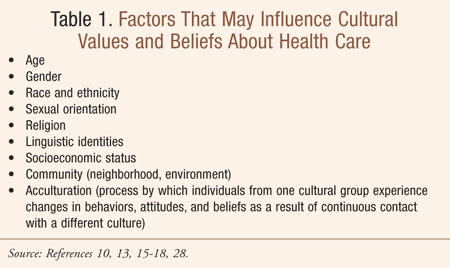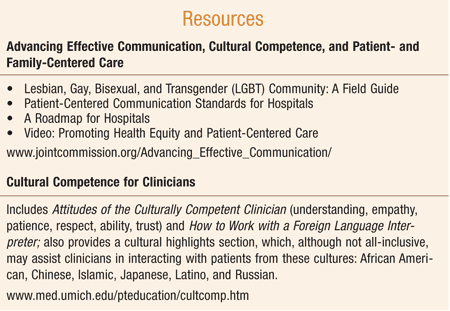The United States population is not only aging, but it is also increasing in diversity. Approximately 13.3 % of the population is now 65 years of age or older, and approximately 42% of the general population identifies as African American, Hispanic, Asian, American Indian, Alaskan Native, being of another race that is not White, or as coming from two or more races.1
As the age and diversity of our population increases, so does the potential for patients, including older adults, to experience barriers to health care access. Therefore, pharmacists and other clinicians must continue to strive for effective communication with sensitivity toward cultural, socioeconomic, and sociodemographic factors. Furthermore, seniors who do achieve access to care need to be fully engaged in the clinician-patient encounter so they are able to follow instructions and adhere to medication regimens; engaging an aging and diverse population requires that pharmacists and other health care providers be culturally competent.
Factors Influencing Access to Health Care in Seniors
Among nonelderly Americans, disparities in access to health care have been well documented, with the primary reason being lack of health insurance (i.e., either employer-sponsored or public).2-6 Some sociodemographic factors such as race and income are highly correlated with a lack of insurance in younger populations.7-9
Sociodemographic factors, socioeconomic status, and type of insurance coverage have a substantial impact on the elderly population’s access to health care.10 Among seniors, psychological and physical barriers affect access to care and may be influenced by poverty more than by race.11 The issue of adequate access to health care has attracted the attention of the U.S. Government, professional associations, and health care providers alike.12
In one study supporting this concern, Fitzpatrick et al. evaluated self-perceived access to health care from self-administered questionnaires in a cohort of Medicare beneficiaries with a mean age of 76 years.11 The researchers identified patterns of use and barriers to health care and found the most common barriers to seeing a physician were the doctor’s lack of responsiveness to patient concerns, medical bills, transportation, and street safety. Independently related to perceptions of barriers to access to health care were low income, no supplemental insurance, older age, and female gender; race was not significant after adjustment for other factors.11
Interestingly, there is a perception of greater equality regarding access to health care in U.S. seniors due to their eligibility for Medicare; however, conclusions from recent studies show otherwise. Even for Medicare recipients, cost appears to be one of the significant factors associated with lack of access to care.13-18 Since the greatest financial burden for Medicare recipients involves out-of-pocket expenses, issues of cost in the elderly are primarily related to insurance coverage that is supplemental to Medicare coverage.16 This type of insurance has been reported to be independently related to both the use of health services and medical outcomes.14,17 Lack of complementary health insurance may affect the health care services received by individuals aged 65 years and older, in addition to race, education, age, and gender.13,15-18
Striving for Cultural Competence
Numerous studies indicate that satisfaction with provider services may impact perceptions of access to health care, in addition to clinical outcomes.19-22 As noted above, lack of responsiveness to patient concerns is commonly perceived as a barrier to access to care among older adults.11 A factor in patients’ perceptions of clinicians’ responsiveness may be their ability to make patients feel respected and understood regardless of cultural differences between them.
We, as individuals, are defined by our culture.23 Further, a variety of factors that mold behavior and values have the potential to influence cultural values and beliefs toward health care (TABLE 1).24 The ultimate goal of a health care provider is to improve patient outcomes; achieving this goal includes understanding the culture and language of patients.24 To provide quality care to patients who come from a variety of cultures and backgrounds, health care providers, including pharmacists, should strive toward cultural competence. Cultural competence is the ability of individuals and systems to respond respectfully and effectively to people of all cultures, classes, races, ethnic backgrounds, sexual orientations, and faiths or religions in a manner that recognizes, affirms, and values the worth of individuals, families, tribes, and communities and protects and preserves the dignity of each.23

The underlying reasons for emphasizing cultural competence in the health care arena are the change in demographics in the U.S., disparities in health, and patient safety.24 It is important for clinical practitioners and their students alike to recognize that patients, including seniors, may enter a health care setting describing their illness with a different explanation than that found in the U.S. medical model. Clinicians need not only to be able to truly listen to a patient’s own perception of health, but also to acknowledge difference and negotiate treatment options, all while being respectful.
Standards for Cultural Competence
Understanding and interpreting accreditation standards for health care organizations and Title VI of the Civil Rights Act are some of the regulatory and legal issues surrounding cultural competence.24 On April 24, 2013, the U.S. Department of Health & Human Services released enhanced National Standards for Culturally and Linguistically Appropriate Services (CLAS) in Health and Health Care—a comprehensive update of the 2000 CLAS Standards—to ensure an even stronger platform for health equity.25 Considered a blueprint to help organizations improve health care quality in serving diverse communities, these enhanced standards are grounded in a broad definition of culture in which health is recognized as being influenced by a range of factors from race and ethnicity to language, spirituality, disability status, sexual orientation, gender identity, and geography.25 These standards can be used by stakeholders including policymakers, purchasers, patients, advocates, educators, and the health care community in general to advance health and health care in the U.S.25
There is support for CLAS standards by the primary national accrediting body for health care organizations and programs, the Joint Commission, which requires effective communication, cultural competence, and patient-oriented care (see RESOURCES). Cultural competence, therefore, can be demonstrated by an organization when that entity has a defined set of values and principles (i.e., mission), policies, and the necessary structures for the delivery of services that incorporate community input and enable persons in the organization to effectively perform within cultures and cross-culturally.26,27 Although barriers exist for cross-cultural communication, they can be overcome if clinicians understand verbal and nonverbal cues in communication.24 Pharmacists and other clinicians should also recognize and embrace the fact that it is essential to have quality interpretation in the patient encounter.

Conclusion
Access to health care has been viewed as a primary concern, particularly among the elderly population. Ineffective communication may contribute to this concern, in addition to negatively affecting medication adherence, therapeutic outcomes, and patient safety. Navigating across cultures requires tools such as learning how to listen, empathize, and negotiate a treatment and pharmaceutical plan with patients. Without cultural competence, effective communication regarding these issues may be compromised.
REFERENCES
1. U.S. Census Bureau. 2011 American
Community Survey 1-year Estimates and 2009-2011 American Community
Survey 3-Year Estimates - United States.
http://factfinder2.census.gov/faces/nav/jsf/pages/searchresults.xhtml?refresh=t.
Accessed August 19, 2013.
2. McCormick MC, Weinick RM, Elixhauser
A, et al. Annual report on access to and utilization of health care for
children and youth in the United States–2000. Ambul Pediatr. 2001;1:3-15.
3. Reed MC, Tu HT. Triple jeopardy: low income, chronically ill and uninsured in America. Issue Brief Cent Stud Health Syst Change. 2002;49:1-4.
4. Broyles RW, Narine L, Brandt EN Jr. The temporarily and chronically uninsured: does their use of primary care differ? J Health Care Poor Underserved. 2002;13:95-111.
5. Cunningham PJ. Declining employer-sponsored coverage: the role of public programs and implications for access to care. Med Care Res Rev. 2002;59:79-98.
6. Guyer J, Broaddus M, Dude A. Millions
of mothers lack health insurance coverage in the United States: most
uninsured mothers lack access both to employer-based coverage and to
publicly subsidized health insurance. Int J Health Serv. 2002;32:89-106.
7. Keruly JC, Conviser R, Moore RD. Association of medical insurance and other factors with receipt of anti-retroviral therapy. Am J Public Health. 2002;92:852-857.
8. Ruiz P. Hispanic access to health/mental health services. Psychiatr Q. 2002;73:85-91.
9. Strzelczyk JJ, Dignan MB. Disparities
in adherence to recommended followup on screening mammography:
interaction of sociodemographic factors. Ethn Dis. 2002;12:77-86.
10 Shi L, Stevens G. Vulnerable Populations in the United States. San Francisco, CA: Jossey-Bass, 2005.
11. Fitzpatrick AL, Powe NR, Cooper LS, et al. Barriers to health care access among the elderly and who perceives them. Am J Public Health. 2004; 94(10):1788-1794.
12. Smith MA. Access to health care among the elderly. NP World News. 2010;15(11/12):18-19.
13. Schneider EC, Zaslavsky AM, Epstein AM. Racial disparities in the quality of care for enrollees in Medicare managed care. JAMA. 2002;287:1288-1294.
14. Porell FW, Miltiades HB. Access to care and functional status change among aged Medicare beneficiaries. J Gerontol B Psychol Sci Soc Sci. 2001;56:S69-S83.
15. Gornick ME. The association of
race/socioeconomic status and use of Medicare services: a little-known
failure in access to care. Ann N Y Acad Sci. 1999;896:497-500.
16. Janes GR, Blackman DK, Bolen JC, et al. Surveillance for use of preventive health-care services by older adults, 1995–1997. MMWR CDC Surveill Summ. 1999;48:51-88.
17. Hsia J, Kemper E, Sofaer S, et al. Is
insurance a more important determinant of healthcare access than
perceived health? Evidence from the Women’s Health Initiative. J Womens Health Gend Based Med. 2000;9:881–889.
18. Escarce JJ, Epstein KR, Colby DC,
Schwartz JS. Racial differences in the elderly’s use of medical
procedures and diagnostic tests. Am J Public Health. 1993;83:948-954.
19. Akinci F, Sinay T. Perceived access in a managed care environment: determinants of satisfaction. Health Serv Manage Res. 2003;16:85-95.
20. Meng YY, Jatulis DE, McDonald JP, Legorreta AP. Satisfaction with access to and quality of health care among Medicare enrollees in a health maintenance organization. West J Med. 1997;166:242-247.
21. Harris LE, Luft FC, Rudy DW, Tierney
WM. Correlates of health care satisfaction in inner-city patients with
hypertension and chronic renal insufficiency. Soc Sci Med. 1995;41:1639-1645.
22. Alazri MH, Neal RD. The association
between satisfaction with services provided in primary care and outcomes
in type 2 diabetes mellitus. Diabet Med. 2003;20:486-490.
23. Child Welfare League of America. CWLA
National Advisory Committee on Cultural Competence and Racial
Disproportionality and Disparity of Outcomes. Cultural competence: about
this area of focus.
www.cwla.org/programs/culturalcompetence/culturalabout.htm. Accessed
August 18, 2013.
24. Sias JJ, Loya AM, Rivera JO, et al. Cultural competency. In: DiPiro JT, Talbert RL, Yee GC, et al, eds. Pharmacotherapy: A Pathophysiologic Approach. 8th ed. New York: McGraw-Hill; 2011. Chapter 4. www.accesspharmacy.com/content.aspx?aID=7965864. Accessed August 11, 2013.
25. HHS releases blueprint to advance
culturally and linguistically appropriate services in health and health
care. U.S. Department of Health & Human Services. April 24, 2013.
Revised August 5, 2013.
www.hhs.gov/news/press/2013pres/04/20130424b.html. Accessed August 26,
2013.
26. AgingStats.gov. Federal Interagency
Forum on Aging-Related Statistics. Number of older Americans.
www.aoa.gov/agingstatsdotnet/Main_Site/Data/2008_Documents/Population.aspx.
Accessed August 16, 2013.
27. National Healthcare Disparities
Report, 2007. Agency for Healthcare Research and Quality.
http://archive.ahrq.gov/qual/qrdr07.htm. Accessed August 16, 2013.
28. Moyerman DR, Forman BD. Acculturation and adjustment: a meta-analytic study. Hisp J Behav Sci. 1992;14(2):163-200.
To comment on this article, contact rdavidson@uspharmacist.com.





